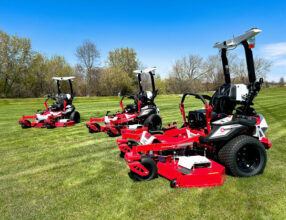Take your shop to the next level
By Bob Clements
Regardless of where your dealership is located in North America, the busy season has arrived and service work is overtaking most dealers’ ability to handle the volume. As you know, your shop can go from having no business to completely swamped in 24 hours. Even though most of you are in the heat of the service battle, I want to encourage you, as I do all of my dealers, to take time to tune up your shop and maximize profits while business is red hot.
I know that I worked with several of you to make some radical changes in how you do service. Some of you did some cleaning, changed compensation plans for your techs, and even added a service lift to improve the efficiencies of your techs. While all of these changes are great, the reality of a shop is that you can’t just make a one-time change and assume all is going to work well.
As business owners, we often get so busy during the day that we forget how important it is to make adjustments to our business all yearlong. Think of your dealership like a customer’s lawn mower that sat all winter. When mowing for the first time in the spring, the mower starts and cuts, but not as well as the customer remembers it doing at the end of the previous season. Your shop is the same as that lawn mower. It has been dormant for several months, and now you have started it up and have it working. At the start of the season, your shop seemed to be running fine because the work was flowing in a little at a time — the grass was not very tall. Now with the season in full swing, your shop is loaded with work and you are struggling to keep up with the flow — you now find yourself knee-deep in tall, wet grass.
In this article, I want to walk you through three quick shop adjustments, which will allow you to increase the flow of equipment through your service department and maximize your profits.
1. Tune up your check-in
The work of the service department starts when your dealership makes contact with a customer — either at the customer’s home when you are picking up a piece of equipment or at your dealership when the customer drops off the equipment. That moment in time sets in motion your service process. If the equipment is checked in properly and the customer is advised of the equipment’s basic condition (flat tires, bad tires, low or no oil in the engine, oil condition, dirty air filter, cables loose or frayed, starter rope worn or frayed), you are well on your way to improving your service efficiency.
Every piece of information you can glean at that point in time will add to your shop’s ability to turn that equipment around quickly for a customer. It may seem like you are so busy that you just don’t have an extra few minutes to spend with a customer and go over the equipment. But, the initial investment you make can save your shop precious time and money as it services the customer’s equipment. Commit to investing the up-front time to complete a thorough check-in with every customer.
Let’s say that a customer brings in a walk-behind mower that has an engine that was “knocking” and then just stopped. While with the customer, the employee, who is checking the oil, notices that the dipstick is rusted on the end and there is no oil in the unit. At that time, the employee can tactfully talk to the customer about the importance of oil in an engine and have the customer consider purchasing a new mower rather than wasting the service department’s time to tell the customer the engine is trashed.
Also, don’t forget that obtaining numbers — model and engine number, customer phone and cell phone number — as well as an e-mail address are also a critical part of your check-in procedure. It amazes me how much time can be saved by communicating to customers by e-mail rather than leaving message after message, hoping they will get back with approval to do work on their machine.
2. Tune up your pricing
For some reason, this year I have struggled to convince dealers to increase their labor rates by a few dollars over last year. Most of my dealers feel that with the currently tough economic conditions, it’s not the time to get more aggressive. While I do appreciate a dealer’s willingness to “spread the wealth,” I am more concerned that a dealer tries to hold on to some of it. I promise you that, as a dealer, doing business this year is going to cost you more than doing business last year. Insurance costs are up; workers’ compensation costs are up; healthcare costs are up; and local, state and federal taxes are going to go up.
For those reasons alone, charging what you charged last year is just not going to work. How much should you charge for labor? There are many factors to consider, and I won’t be able to cover them in detail in this article. But I will tell you what I have told every dealer I work with: Now is the time to raise your rates. I know it may feel a little strange to raise your rates during season; most dealers do that at the first of the year, which is a bad time to do it. The best time to raise your rates is now, when the demand for your service is high.
Think of your service department like an airline. If you wanted to purchase a ticket for a trip you are going to take 60 days from now, you could take your time and shop for the best airfare. At this point, price is more important to you than time. You have plenty of time and might as well take advantage of it. By booking early, you can save potentially hundreds of dollars on a ticket. However, if you have a family emergency and need to book a flight for tomorrow, the price of the ticket has nothing to do with your purchasing decision. At that point, you are more interested in finding an airline that will get you to your destination regardless of the cost, because time is more important than price.
Today, you have that exact same scenario playing out in your service department. In January, your customers were not in a hurry, so saving money was important to them. That’s why many of you offered discounts or free pickup and delivery to entice customers to get their equipment in before the busy season. Now, however, the busy season is upon us, the grass that the homeowner so carefully fertilized is growing at an alarming rate, and yards need to be mowed every seven days. Time has now become more important than price. In January, customers asked how much would it cost; today, they ask when will it be done. There is a big difference in the attitude, and now is when you should make a minor adjustment to generate the extra profits you are going to need to stay even with last year.
Again, I am not recommending you make a huge jump; just a few dollars more per hour will have a significant impact on your bottom line. If you have two service techs working for your dealership and they bill out a minimum of 1,500 hours each between now and the end of the year, a $3 increase will add $9,000 net profit to your bottom line. Keep in mind, that’s $9,000 net (in your pocket) profit, not gross profit. Take time over the next couple of weeks to tune up your pricing.
3. Tune up your techs
When I work with the service techs at a store, my goal is to help them — and management — understand the value they bring to a dealership and how they can do their work in the most efficient way possible. A service tech’s inventory is “time” and your goal as a dealer is to sell all of the tech’s time each day. Is it possible to sell eight hours of labor each day per tech? Absolutely. Most of my dealers sell more than that. I am a NASCAR fan and love to watch the efficiency of a pit stop. In most stops, a pit crew can change four tires, adjust the suspension, and fuel a car in less than 13 seconds. Why then does it take a car dealership more than 16,000 times longer (about an hour) to put new tires on your car? It’s all about planning.
In a pit stop, the crew chief (service manager) has been in constant communication with the driver throughout the race and knows what changes need to be made before the car ever hits the pit stop. His people are positioned with the tools and parts they need to get the work done in the least amount of time possible. Everything is set and ready to go the moment that car comes to a stop. They don’t wait until it gets there to find the tires, and locate the jack or impact wrench. It’s all there ready to go.
When a piece of equipment comes into your service tech’s area, it has just entered the pit. I challenge you to stand back and watch what takes place. Is the tech ready to start working on the equipment or is time being wasted as the tech gets ready to start working. Does the tech have the right tools, the right parts and the right equipment to do the service? If not, then every minute the tech wastes costs you money.
In NASCAR, one second more or less in a pit stop can mean the difference between winning and losing a race. One second doesn’t seem like much, but in a NASCAR race, it is equal to about 200 feet or about 10 car lengths. As a business owner, I always think better when I put things in terms of costs. If your posted labor rate is just $60 per hour, one minute of wasted time costs you $1. That may seem insignificant until you look at how many minutes are wasted on every repair your shop completes.
One tech wasting 30 minutes per day could cost you more than $7,000 per year of unbilled labor. Multiply that by a couple of techs, and you start talking about some real money. It’s not that hard to eliminate that waste, if you are willing to spend some time watching what happens and improving your processes.
You may find that your techs are wasting time waiting for parts to work on equipment. If that’s the case, change your process and pre-diagnose equipment so that they have the parts they need before the equipment comes in to be serviced. If that is not possible, at least have the fast-moving parts they need — blades, filters, plugs and oil — right beside them so they don’t have to take time to get them from the parts department.
Have the equipment they are going to work on each day staged, so they are not wasting time dragging it out from behind the new pile of equipment that came in the previous day. Hire a high-school kid to test and wash the equipment after it is serviced instead of having the techs use their valuable time doing it.
Look at the tools you have and consider investing in equipment that will speed up your process. Something as simple as a service lift can add six minutes per service hour to your shop. In an average day, you have added about 45 minutes of service time or, at $60 per hour, your techs could bill out another $45 in labor. For just one tech, you can add another $8,000 to your bottom line. Don’t forget about extra air hoses or even another broom so that your techs aren’t walking around trying to find the one broom the shop has that someone has misplaced.
Take some time over the next week and look at your check-in process. Are you and your employees getting the right information, so that when the equipment reaches the service department, it can easily be moved through the process and back into the customer’s hands in a smooth, seamless process? If not, make some adjustments. It is not the time to make sweeping changes, but a few minor adjustments won’t upset your system and can make a big impact on your turnaround time for your service.
Think about your pricing. If you are already behind and have customers pounding on you to get their equipment serviced, is there any reason why you couldn’t or shouldn’t move that posted shop rate up a few dollars? An increase of just a few dollars an hour won’t be noticed by a customer this time of year and, depending on your number of techs, could add thousands of dollars to your net profit.
And finally, do a quick evaluation of your techs and the time that may be wasted by waiting for parts, moving equipment in and out, or crawling around on a floor instead of using a service lift to get the equipment up in the air and serviced efficiently.
Invest some time and fine-tune your shop and processes. If you do, you can take advantage of the busy season and make your service department a money-making machine.
Bob Clements is the president of Bob Clements International, Inc., a consulting firm that specializes in the development of high-performance dealerships. His organization works hands on with dealerships throughout North America, helping them attain the personal freedom and financial wealth all owners strive to achieve. For more information, contact Bob Clements at (800) 480-0737 or bob@bobclements.com or visit his Web site at www.bobclements.com.



